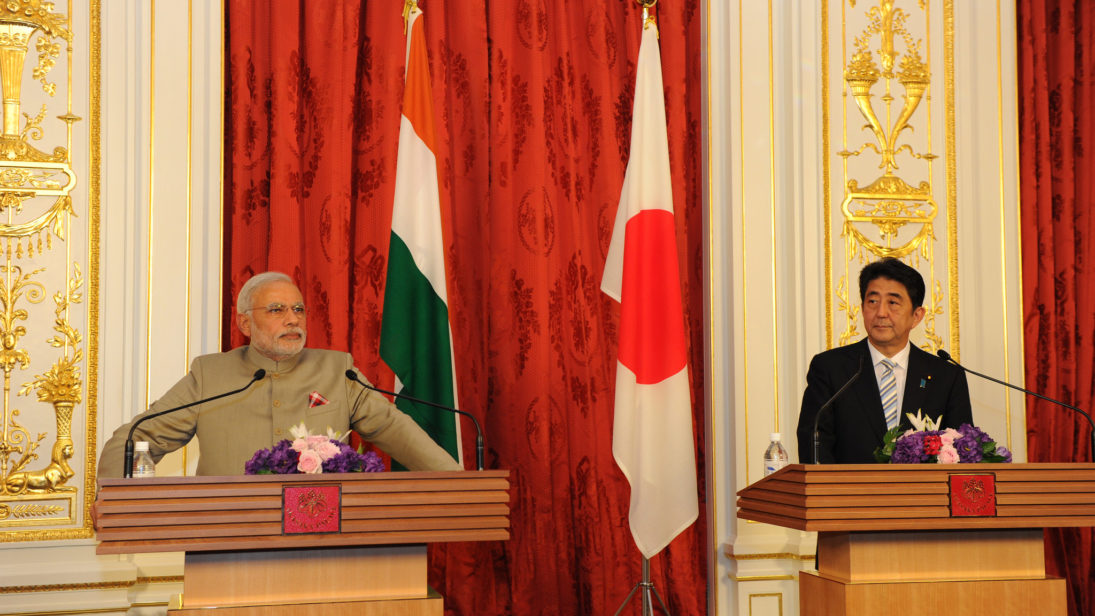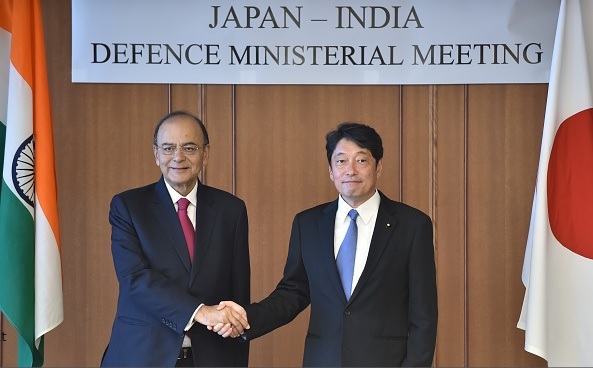
For a country that twice punished New Delhi for its defiance of nuclear nonproliferation regimes, Japan has come a long way in its relationship with India, with the two now joining hands to change the course of Asia’s security dynamics. Needless to say, Japanese Prime Minister Shinzo Abe’s visit to India next week is highly significant as both countries look for enhanced cooperation, especially in light of recent tensions between China and India, and President Trump’s “America first” policy.
Among the highlights of the visit is the launch of the multi-billion dollar high-speed railway project connecting Mumbai and Ahmedabad using Japan’s Shinkansen technology, an indication of the extent of their economic partnership. But now it is time to take the strategic relationship to the next level. If a strategic partnership is to endure between India and Japan, then it must contribute to hard power mechanisms based on arms sales or the joint production of defense systems.
Japan’s Economic Push in India
Ever since the Comprehensive Economic Partnership Agreement (CEPA) was signed in 2011, Japan has become a major economic partner of India. Japan has invested over $25 billion in different sectors in India from 2000-2017 and is now the third biggest investor in the country. Japan has also committed around $35 billion for the period 2014-19 to boost India’s manufacturing and infrastructure. Japanese assistance in areas such as railroad connectivity, road building, electricity, and disaster management has been vital for India in its effort to develop infrastructure in the strategically-important northeastern sector close to the Chinese border. Recently, amid the Doklam standoff, the two countries launched the India-Japan Coordination Forum for Development of North East.
Case for Elevating Defense Ties
China’s expanding influence in the Indo-Pacific region threatens both Indian and Japanese interests. Thus, to balance Chinese dominance in the region, the two countries need to strengthen their defense partnership.
Additionally, the United States may not intervene in a crisis in the region unless it threatens U.S. interests. The Trump administration’s approach to security in the region is rooted in offshore balancing. The United States prefers strong regional powers managing their own security affairs and helping preserve the global commons so that it can focus directly on China’s assertiveness. For the United States, regional powers like India, Japan, and Australia can manage security affairs in the region with U.S. support from the sidelines, a la Mearsheimer’s offshore balancing strategy. Since India and Japan are strategic partners of the United States and regional powers in Southeast Asia do not have any qualms about strong India-Japan ties, the Indo-Japanese relationship has the potential to become a major contributing factor to the stability of the Indo-Pacific region.

What Would This Cooperation Look Like
Although Tokyo and New Delhi signed a strategic partnership agreement in 2006, synergy between the two with regard to hard security matters is underdeveloped and this aspect of the relationship seems to revolve largely around bilateral visits, dialogues, and joint statements. Today, both countries are modernizing their armed forces and indigenously developing an ecosystem to meet their security needs. Prime Minister Narendra Modi’s Make in India program aims to reduce India’s dependence on foreign vendors and nurture domestic companies as the lead producers of defense systems. Also, recently, India eased its defense procurement policy for private companies and liberalized foreign investment norms in the defense sector. Tokyo is gradually shedding the pacifist nature of its defense policy and building advanced platforms to transform into a “normal” country. Having lifted its arms export embargo a few years ago, Japan seems to be pushing for a share of the global arms trade, especially in the Asian market, and fiercely battled to win the $40 billion Australian conventional submarine contract for its Soryu-class ships, though it eventually lost out to DCNS of France.
Most major Asian countries are spending millions of dollars to enhance their defense forces, but are still looking to the West for arms and ammunition. So far, no Asian country has established a niche in the global arms trade business. Technological investments to support Indian manufacturing are in Japan’s interest, especially in the defense production sector, as it will address the issues of large-scale production and economies of scale. The fact that Southeast Asian countries like Vietnam have already expressed interest in buying India-made arms for its defense forces and developing defense partnerships with both countries suggests that the region will be a ripe market for this India-Japan joint venture.
India and Japan now view the maritime security domain as a major area of defense cooperation. For instance, the Malabar trilateral maritime exercise has become an annual event. Meanwhile, India plans to spend billions of dollars to emerge as a formidable maritime power in the Indian Ocean. At the same time, Japan, thanks to a repository of advanced technology, is constructing sophisticated naval systems, including conventional submarines and destroyers, to face the challenges posed by China in its eastern seas. Tokyo’s main concern about trade in dual-use technology was its apprehension about whether New Delhi would use Japanese technology for India’s nuclear military program. With the signing of a civil nuclear deal between the two, which entered into force this July, both countries can now cooperate on the joint development and co-production of defense systems. Japan’s Mitsubishi-Kawasaki consortium has evinced interest in participating in India’s $8 billion submarine project deal, and if New Delhi agrees, it would be a major boost to the hard power relationship between the two.
The sustenance of the relationship will depend on how both can contribute to the hard power mechanism of security in the Indo-Pacific, which in turn will be based on the progress in the joint development and production of defense technologies. Given that both countries have displayed their willingness to forge a more cooperative defense partnership, it seems likely that these two regional giants could transform the security situation in the region.
***
Image 1: MEA Photogallery via Flickr
Image 2: Kazuhiro Nogi/AFP via Getty Images


